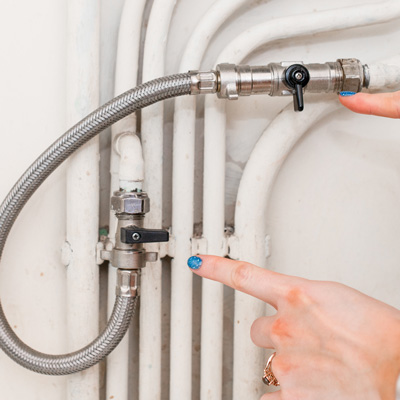Step 1
Step 1: Locate your pressure gauge
Locate the pressure gauge on your boiler. It’ll either be a digital gauge or a clock gauge with needles.
Low water pressure in your boiler might be the reason you have no hot water in your home. Fear not, it’s easy to spot and, in virtually all cases, you can increase it yourself without a heating engineer needing to visit.
Boilers heat cold water that flows around a circuit of pipes and radiators throughout the home. Water pressure needs to be stable in order for the boiler to work as efficiently as possible, but it can be affected by a leak or even the bleeding of a radiator. Even the tiniest of leaks can cause a loss of pressure if it’s gone unnoticed for some time, so it’s worth having a look around your home for signs of wet patches around radiators, pipes and the boiler itself (don’t open up the boiler though). Similar, if you’ve bled a radiator recently, the air it released may have caused a loss of pressure in your boiler system.
Follow the below steps to increase the increase your boiler...
Step 1
Locate the pressure gauge on your boiler. It’ll either be a digital gauge or a clock gauge with needles.

Step 2
Digital gauges show the current pressure level and, if it’s too low (or high), will display a flashing warning or an error code. On a clock gauge, the black needle shows you the current pressure level. The ideal pressure is between 1 bar and 2 bar. If your reading is higher than 2.75, we recommend that a heating engineer comes out to check your system. Please refer to your boiler manual if you need help reading your pressure gauge.

Step 3
Boiler pressure systems differ, so it’s always best to refer to your manual for instructions on how to re-pressurise it. You may even find a helpful tutorial or video on the manufacturer’s website or YouTube channel; we recommend googling the brand and model number. When you re-pressure your boiler, cold water from the mains supply is allowed to enter the system via the filling loop that connects to your cold water pipe. Follow the next steps for the basic re-pressurising process.
Step 4
If your pressure is below the ideal 1-2 bar level, you can top it up. First, turn off the boiler and allow it to cool.

Step 5
Locate your filling loop. They can vary in design but will be either built-in or external. Built-in ones tend to have one or two identical keys or taps, whereas external ones look like a small hose with taps attached at either end. If the latter, ensure both ends of the filling loop are securely attached.

Step 6
Open both valves, to allow cold mains water into the system (you should hear it).

Step 7
Wait for the pressure gauge to read 1.5 bar.

Step 8
Close both valves, one after the other.

Step 9
Switch the boiler back on and, if needed, press the reset button. If low pressure problems persist, we recommend that a heating engineer takes a look as it may mean there’s a small water leak somewhere within the system that needs repairing.

To find out how we can help you, e-mail us via enquiries@cpshomes.co.uk or give us a call on 02920 668585. Alternatively, if you fancy calling in for a face-to-face chat, we'd love to see you.